Curly Top Virus
Curtovirus spp.
 Beet leafhopper vector and spread curly top virus.
Beet leafhopper vector and spread curly top virus.

Curly top virus damage to field-grown hemp plant.
Hosts
- Field-grown hemp
- Vegetables
- Ornamentals
- Weeds
Symptoms
Infected hemp plants become stunted and show a yellow mosaic pattern on leaves or leaves become completely chlorotic.
Disease Cycle
The virus is spread by leafhoppers. Beet leafhoppers (Circulifer tenellus) migrate north in early summer from their overwintering locations. They acquire the virus by feeding on infected host plants and then transmit it for their entire life. The virus is transmitted quickly during leafhopper probing and feeding on host plants.
Time for Concern
Throughout the growing season, but particularly when plants are small.
When and Where to Scout
- Scout plants biweekly looking for stunting and yellow mosaic or general chlorosis on leaves.
- Plants that have yellow mosaic patterns on their leaves can be submitted to the Utah Plant Pest Diagnostic Lab for testing.
- Scout for beet leafhopper starting in spring by visually inspecting the undersides of leaves, or using yellow sticky cards placed at field edges.
- Beet leafhoppers often come from weeds surrounding the field, so begin scouting there early in the season.
Threat Level
Medium.
Occurrence in Utah
Curly top virus has been detected on field-grown hemp in Utah in low incidence.
Management
- Exclude or "confuse" leafhoppers by covering crops with row covers.
- Plant hemp further away from susceptible crops like beets or tomatoes to reduce infection.
- Destroy and remove plant debris. Weeds or volunteer plants from previous crops can act as overwintering hosts for leafhoppers and the virus.
- Keep field borders and interiors clear of weeds; this will reduce food sources for incoming infected leafhoppers in the spring and summer.
Look-alikes
Tomato spotted wilt virus (early in the season).
Photo Credits (From top to bottom)
- G. Oldfield, USDA, Bugwood.org
- USU Extension IPM Program



